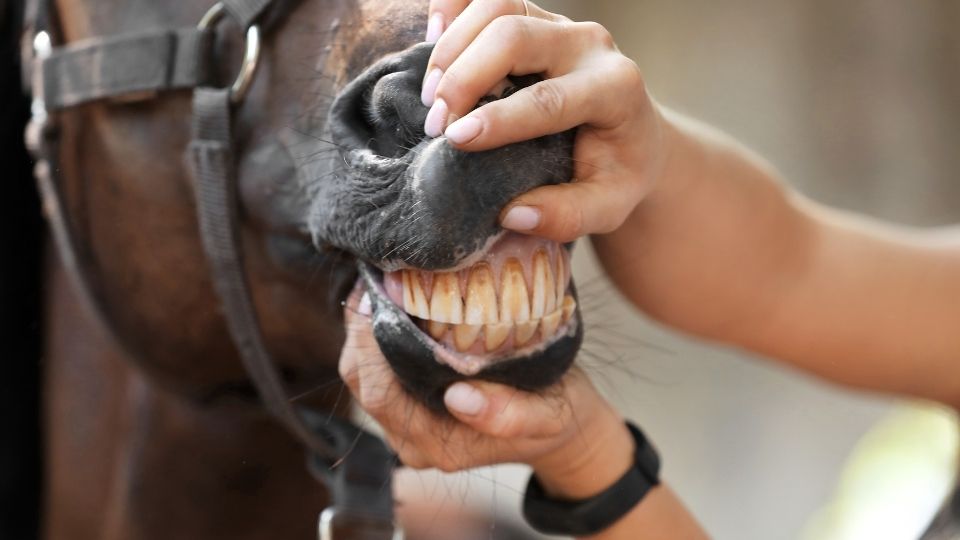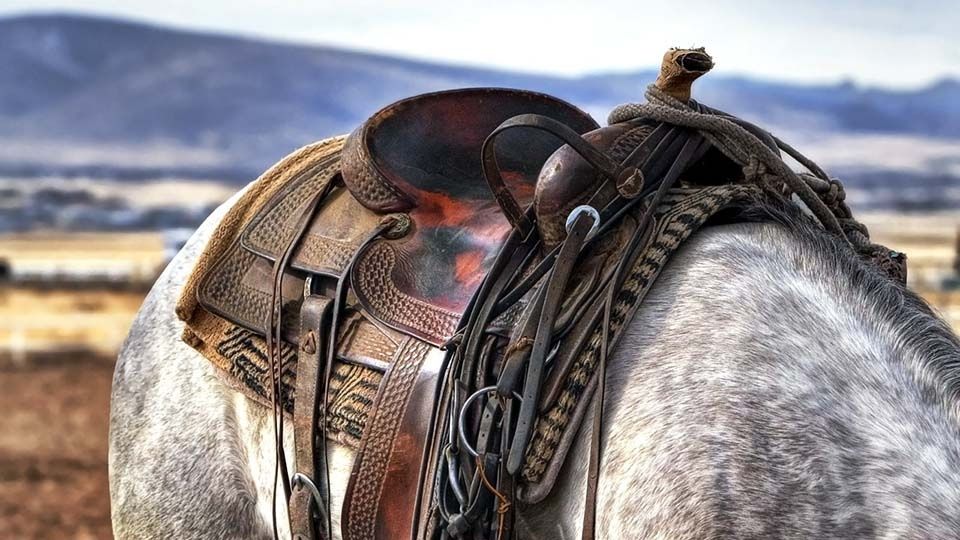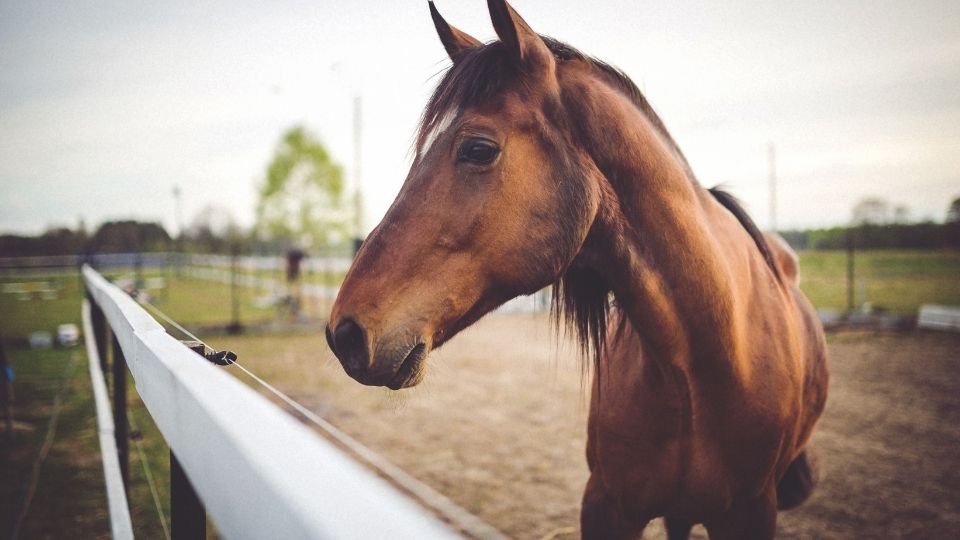Equine Nutrition: Concentrates
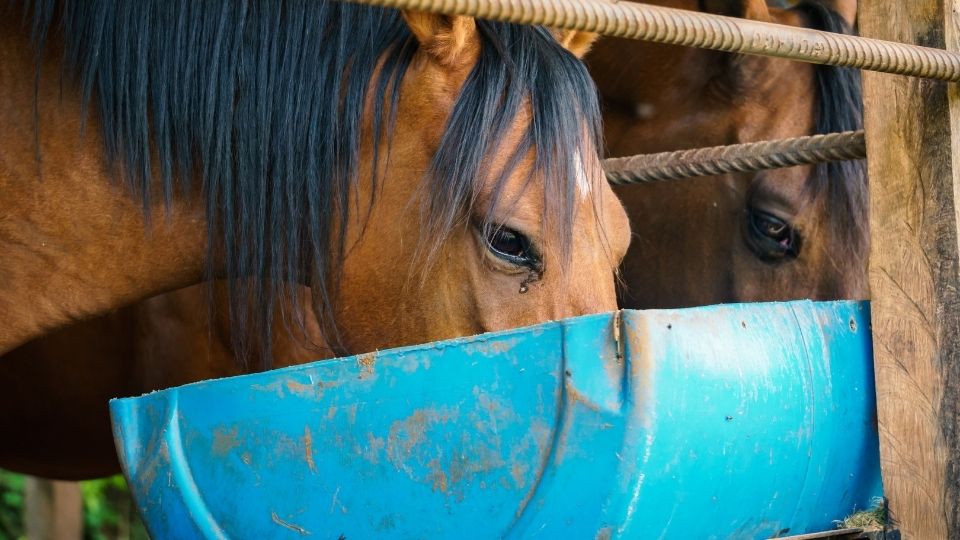
Concentrates (grain) should be considered only as supplements to good quality hay. In general, a mature horse does not require the energy that would be provided by concentrate type feeds (grains/sweet feeds, pelleted feed, etc.) unless the horse is used for more than light work and/or in production such as a lactating mare or a breeding stallion. Too many times horses are over fed rather than underfed. This fact sheet will help horse owners understand the digestive process and the general feeding requirements for their horses. Concentrates do, however, play an important part of the growing foal’s diet up to maturity, even contributing up to 50% of the ration in the first 2- 3 years of growth. Owners must understand the importance of balancing the ration so that proper amount and ratios of minerals, vitamins, proteins, fats, carbohydrates, etc., are maintained for correct growth and maintenance. Unless there are high energy and/or growth requirements for the current age and level of work, slight increases in hay can provide the extra energy to balance the diet needs.
The Digestive Tract
The horse’s gut is designed to handle small amounts of feed throughout the day. The horse’s stomach and small intestine are responsible for breakdown and absorption of the grain (concentrate) portion of the diet. Hay will pass through the stomach quickly, as it is not digested until it reaches the hind gut. With concentrates, little to no absorption occurs in the stomach, although the acidic environment helps with initial breakdown of these food stuffs. Grains fall to the bottom portion of the stomach where gastric juices reduce proteins and fats to intermediate products. The small intestine further reduces proteins, fats and carbohydrates to their basic components for absorption through the membrane of the small intestine.
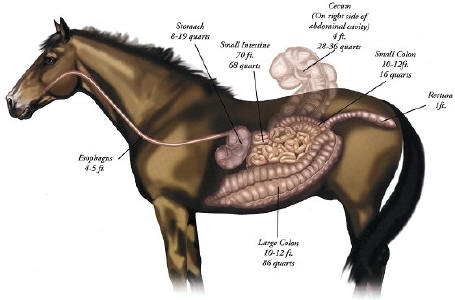
While cattle breakdown molds and toxins in the foregut before absorption occurs, the horse’s site of fermentation and bacterial environment is located after the small intestine, which is the major site of absorption. Therefore, horses should never be fed moldy feed of any kind, as this can cause colic and digestive upset. The toxins from the mold will be absorbed through the small intestine and can lead to laminitis and/or colic.
Concentrates should be fed at as low a level as possible with forage making up the major portion of the diet. Concentrates should be fed at less than 50% of the diet with a 20 – 30 % concentrate level more desirable. This would mean that a 1000 lb mature horse being fed at 2% of its body weight or 20 lbs of feed per day, would receive approximately 14-16 lbs of hay and 4 – 6 lbs of concentrate. When feeding a diet that consists of both forage and concentrate, hay should be fed first followed by the concentrate. Feeding in this manner will assist in the slow passage of the concentrate portion of the diet allowing for proper digestion in the small intestine. If the concentrate passes through too quickly and reaches the cecum, the pH in the cecum will become more acidic, killing bacteria and potentially causing colic or laminitis.
Concentrates usually fed to horses include oats, barley, and corn in proper balance to satisfy the horse’s nutritional needs. In today’s feed market a wide range of commercially prepared equine concentrates are available being prebalanced for various horse needs from growing rations for young horses to rations for older horses needing additional nutrition to maintain their body condition. It is important that owners know their horse’s needs, the quality and quantity of the hay being fed, and provide a balanced concentrate if needed. Additional supplements added to the diet can interfere with proper balance of the ration and may not provide for that specific horse’s needs.
Balancing your horse’s ration is a fairly complex process. Those who balance rations do so with research proven equine nutrient requirement tables, making it is easy for the horse owner to select an appropriate product and follow label directions.
REMEMBER: Horse owners should visually inspect their horse’s body condition (see fact sheet: AG/Equine/2005-01) and feed to the appropriate body condition score for their horse’s expected performance. Some horses are “easy keepers” or have high energy levels without additional feed supplementation, while others are “hard keepers” and require a full feed of hay and significant supplementation with concentrates. Feed your horse as an individual, watch its body condition, and add and/or subtract feed in relation to your horse’s health and activity level. Along with fresh water, always have a “free choice” salt and mineral supplement available.
Contact your local USU Extension office for details and instructions on having your hay tested for nutritional content to know what, if any, additional supplementation may be needed.
For more information on equine nutrition and forages refer to fact sheet AG/Equine/2006- 02.
References
- Evans, J. W. 1981. Horses. San Francisco: W. H. Freeman and Company.
- Lewis, L. D. 1996. Feeding and Care of the Horse (2nd Ed.). Philadelphia: Lippinott Williams and Wilkins.
Reviewed March 2010
Utah State University Extension
Peer-reviewed fact sheet
Authors
Dr. Patricia Evans, Extension Equine Specialist; Scott McKendrick, Coordinator, Statewide Equine and Small Acreage Program
Related Research


